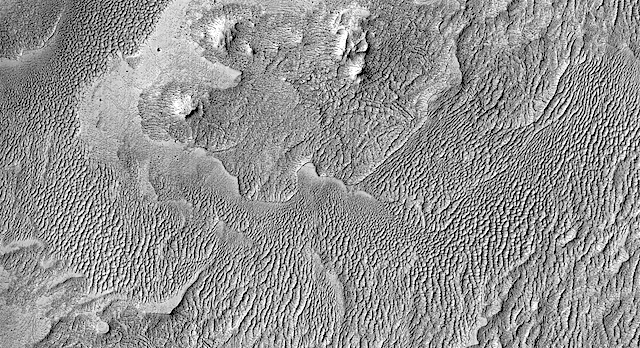 Layers northwest Schiaparelli Crater. The objective of this observation is to determine the extent of layers in this part of Schiaparelli Crater.
Layers northwest Schiaparelli Crater. The objective of this observation is to determine the extent of layers in this part of Schiaparelli Crater.
HiRISE Picture of the Day archive [More at links]
 Layers northwest Schiaparelli Crater. The objective of this observation is to determine the extent of layers in this part of Schiaparelli Crater.
Layers northwest Schiaparelli Crater. The objective of this observation is to determine the extent of layers in this part of Schiaparelli Crater.
HiRISE Picture of the Day archive [More at links]
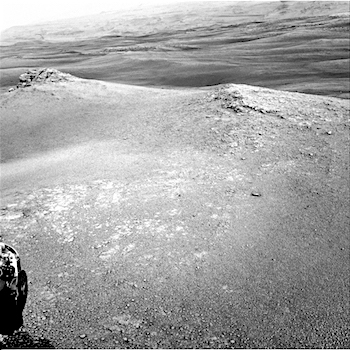 Sols 2304-05, January 29, 2019, update by MSL scientist Christopher Edwards: Today’s plan found Curiosity solidly in new territory and the view couldn’t be more different than the patchy bedrock of the Vera Rubin Ridge. The workspace for the next two sols of planning consisted of fine grained materials with coarser clasts interspersed.
Sols 2304-05, January 29, 2019, update by MSL scientist Christopher Edwards: Today’s plan found Curiosity solidly in new territory and the view couldn’t be more different than the patchy bedrock of the Vera Rubin Ridge. The workspace for the next two sols of planning consisted of fine grained materials with coarser clasts interspersed.
In this plan, despite being power limited resulting in a relatively short science block, the science team managed to squeeze in some important activities to start characterizing the clay-bearing unit. These activities included a ChemCam on a target dubbed “Cyrus” to characterize the limited bedrock in the scene, Mastcam documentation images, several Mastcam mosaics and a long distance RMI to help characterize the Greenheugh pediment visible in… [More at link]
 THEMIS Image of the Day, January 30, 2019. This unnamed crater in Terra Cimmeria has both a sand sheet with dune forms and a multitude of dust devil tracks. The linear and scalloped dark marks are created by dust devils removing surface dust and revealing the darker surface beneath the dust.
THEMIS Image of the Day, January 30, 2019. This unnamed crater in Terra Cimmeria has both a sand sheet with dune forms and a multitude of dust devil tracks. The linear and scalloped dark marks are created by dust devils removing surface dust and revealing the darker surface beneath the dust.
It is common for sand to accumulate in the floor of crater. Changes in the wind occur due to the crater shape and possible internal peak or pit features. As the winds are deflected by this type of feature the sand and dust carried by the wind will settle out.
The extensive number of dust devil tracks indicate that surface winds are pervasive in this region.
 Me and my little friend. A very interesting-looking 5-kilometer crater located in Ascraeus Mons, a large shield volcano located in the Tharsis region of the planet Mars. It is the northernmost and tallest of three shield volcanoes collectively known as the Tharsis Montes.
Me and my little friend. A very interesting-looking 5-kilometer crater located in Ascraeus Mons, a large shield volcano located in the Tharsis region of the planet Mars. It is the northernmost and tallest of three shield volcanoes collectively known as the Tharsis Montes.
HiRISE Picture of the Day archive [More at links]
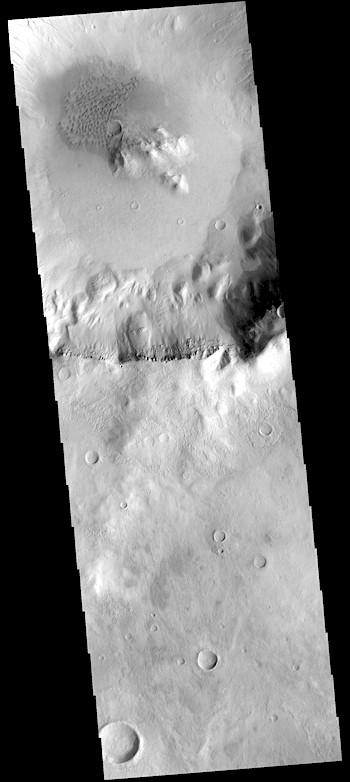 THEMIS Image of the Day, January 29, 2019. A field of sand dunes is visible on the floor of this unnamed crater. The crater is located in Terra Sirenum.
THEMIS Image of the Day, January 29, 2019. A field of sand dunes is visible on the floor of this unnamed crater. The crater is located in Terra Sirenum.
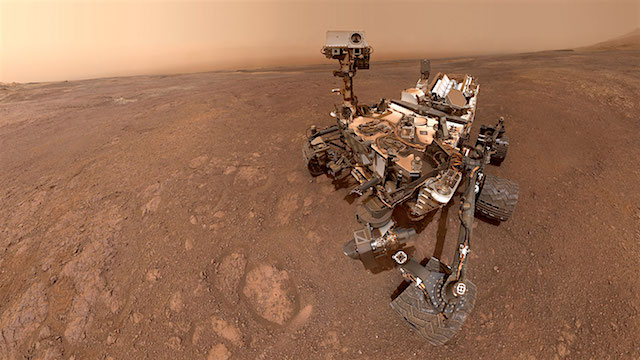 NASA’s Curiosity rover has taken its last selfie on Vera Rubin Ridge and descended toward a clay region of Mount Sharp. The twisting ridge on Mars has been the rover’s home for more than a year, providing scientists with new samples – and new questions – to puzzle over.
NASA’s Curiosity rover has taken its last selfie on Vera Rubin Ridge and descended toward a clay region of Mount Sharp. The twisting ridge on Mars has been the rover’s home for more than a year, providing scientists with new samples – and new questions – to puzzle over.
On Dec. 15, Curiosity drilled its 19th sample at a location on the ridge called Rock Hall. On Jan. 15, the spacecraft used its Mars Hand Lens Imager (MAHLI) camera on the end of its robotic arm to take a series of 57 pictures, which were stitched together into this selfie. The “Rock Hall” drill hole is visible to the lower left of the rover; the scene is dustier than usual at this time of year due to a regional dust storm.
Curiosity has been exploring the ridge since September of 2017. It’s now headed into the “clay-bearing unit,” which sits in a trough just south of the ridge. Clay minerals in this unit may hold more clues about the ancient lakes that helped form the lower levels on Mount Sharp. [More at link]
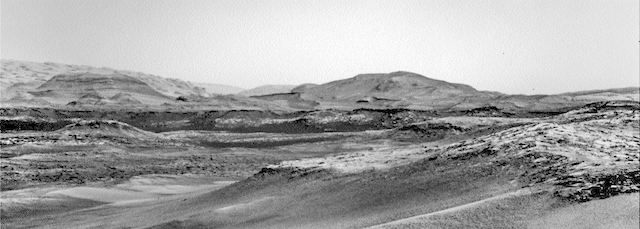 Sols 2301-03, January 28, 2019, update by MSL scientist Ryan Anderson: This weekend’s plan started off on Sol 2301 with some Mastcam atmospheric observations, followed by ChemCam analysis of “Loch Ness” and “Loch Skeen,” examples of brown and gray bedrock. ChemCam also had a long-distance image mosaic of an interesting outcrop in the clay-bearing unit.
Sols 2301-03, January 28, 2019, update by MSL scientist Ryan Anderson: This weekend’s plan started off on Sol 2301 with some Mastcam atmospheric observations, followed by ChemCam analysis of “Loch Ness” and “Loch Skeen,” examples of brown and gray bedrock. ChemCam also had a long-distance image mosaic of an interesting outcrop in the clay-bearing unit.
Once the remote sensing was done, it was time for some contact science. MAHLI collected some images of Loch Ness before and after it was brushed, as well as the target “Puddledub.” APXS then took a turn, with a quick analysis of Puddledub and an overnight analysis of Loch Ness.
On Sol 2302, we started off with a Navcam atmospheric observation, followed by Mastcam multispectral observations of Loch Ness and Loch Skeen. Mastcam also had a large stereo mosaic surveying the clay-bearing unit that we will soon be exploring. We then drove for about 32 meters and collected some… [More at link]
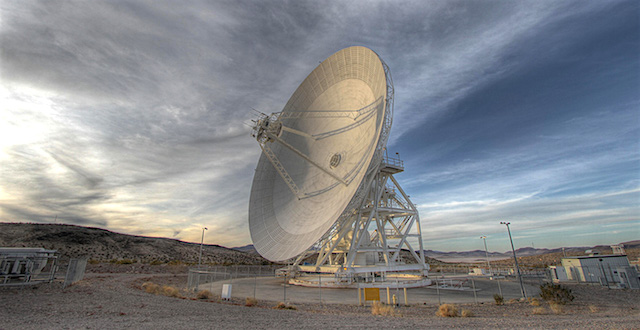 Engineers at NASA’s Jet Propulsion Laboratory in Pasadena, California, have begun transmitting a new set of commands to the Opportunity rover in an attempt to compel the 15-year-old Martian explorer to contact Earth. The new commands, which will be beamed to the rover during the next several weeks, address low-likelihood events that could have occurred aboard Opportunity, preventing it from transmitting. (…)
Engineers at NASA’s Jet Propulsion Laboratory in Pasadena, California, have begun transmitting a new set of commands to the Opportunity rover in an attempt to compel the 15-year-old Martian explorer to contact Earth. The new commands, which will be beamed to the rover during the next several weeks, address low-likelihood events that could have occurred aboard Opportunity, preventing it from transmitting. (…)
“We have and will continue to use multiple techniques in our attempts to contact the rover,” said John Callas, project manager for Opportunity at JPL. “These new command strategies are in addition to the ‘sweep and beep’ commands we have been transmitting up to the rover since September.” With “sweep and beep,” instead of just listening for Opportunity, the project sends commands to the rover to respond back with a beep.
The new transmission strategies are expected to go on for several weeks. They address three possible scenarios: that the rover’s primary X-band radio – which Opportunity uses to communicate with Earth – has failed; that both its primary and secondary X-band radios have failed; or that the rover’s internal clock, which provides a timeframe for its computer brain, is offset…
Time is of the essence for the Opportunity team. The “dust-clearing season” – the time of year on Mars when increased winds could clear the rover’s solar panels of dust that might be preventing it from charging its batteries – is drawing to a close. Meanwhile, Mars is heading into southern winter, which brings with it extremely low temperatures that are likely to cause irreparable harm to an unpowered rover’s batteries, internal wiring and/or computer systems… [More at link]
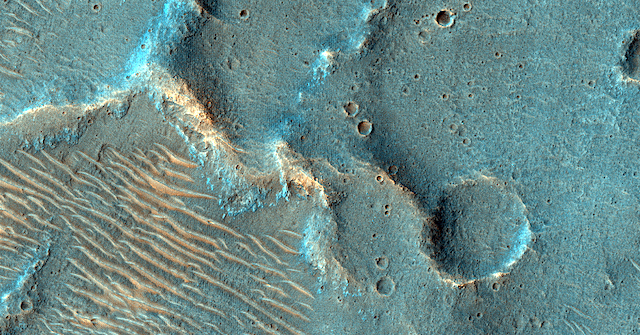 Positive relief features in Xanthe Terra. These relief features, which are positively gorgeous, might be inverted streams. Xanthe Terra is a large area on Mars, centered just north of the Martian equator.
Positive relief features in Xanthe Terra. These relief features, which are positively gorgeous, might be inverted streams. Xanthe Terra is a large area on Mars, centered just north of the Martian equator.
HiRISE Picture of the Day archive [More at links]